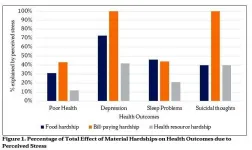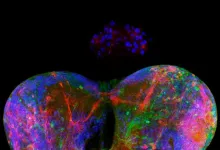(Press-News.org) Astronomers have long been looking into the vast universe in hopes of discovering alien civilisations. But for a planet to have life, liquid water must be present. The chances of that finding scenario have seemed impossible to calculate because it has been the assumption that planets like Earth get their water by chance if a large, ice asteroid hits the planet.
Now, researchers from the GLOBE Institute at the University of Copenhagen have published an eye-opening study, indicating that water may be present during the very formation of a planet. According to the study's calculations, this is true for both Earth, Venus and Mars.
'All our data suggest that water was part of Earth's building blocks, right from the beginning. And because the water molecule is frequently occurring, there is a reasonable probability that it applies to all planets in the Milky Way. The decisive point for whether liquid water is present is the distance of the planet from its star', says Professor Anders Johansen from the Centre for Star and Planet Formation who has led the study that is published in the journal Science Advances.
Using a computer model, Anders Johansen and his team have calculated how quickly planets are formed, and from which building blocks. The study indicates that it was millimetre-sized dust particles of ice and carbon - which are known to orbit around all young stars in the Milky Way - that 4.5 billion years ago accreted in the formation of what would later become Earth.
'Up to the point where Earth had grown to one percent of its current mass, our planet grew by capturing masses of pebbles filled with ice and carbon. Earth then grew faster and faster until, after five million years, it became as large as we know it today. Along the way, the temperature on the surface rose sharply, causing the ice in the pebbles to evaporate on the way down to the surface so that, today, only 0.1 percent of the planet is made up of water, even though 70 percent of Earth's surface is covered by water', says Anders Johansen, who together with his research team in Lund ten years ago put forward the theory that the new study now confirms.
The theory, called 'pebble accretion', is that planets are formed by pebbles that are clumping together, and that the planets then grow larger and larger.
Anders Johansen explains that the water molecule H2O is found everywhere in our galaxy, and that the theory therefore opens up the possibility that other planets may have been formed in the same way as Earth, Mars and Venus.
'All planets in the Milky Way may be formed by the same building blocks, meaning that planets with the same amount of water and carbon as Earth - and thus potential places where life may be present - occur frequently around other stars in our galaxy, provided the temperature is right', he says.
If planets in our galaxy had the same building blocks and the same temperature conditions as Earth, there will also be good chances that they may have about the same amount of water and continents as our planet.
Professor Martin Bizzarro, co-author of the study, says:
'With our model, all planets get the same amount of water, and this suggests that other planets may have not just the same amount of water and oceans, but also the same amount of continents as here on Earth. It provides good opportunities for the emergence of life', he says.
If, on the other hand, it was random how much water was present on planets, the planets might look vastly different. Some planets would be too dry to develop life, while others would be completely covered by water.
'A planet covered by water would of course be good for maritime beings, but would offer less than ideal conditions for the formation of civilisations that can observe the universe', says Anders Johansen.
Anders Johansen and his research team are looking forward to the next generation of space telescopes, which will offer far better opportunities to observe exoplanets orbiting a star other than the Sun.
'The new telescopes are powerful. They use spectroscopy, which means that by observing which type of light is being blocked from the planets' orbit around their star, you can see how much water vapour there is. It can tell us something about the number of oceans on that planet', he says.
INFORMATION:
New research by Swansea scientists in collaboration with scientists at the University of Bristol and the Francis Crick institute in London has indicated that consuming a diet high in the sugar fructose might prevent the proper functioning of peoples' immune systems in ways that has, until now, largely been unknown.
Fructose is commonly found in sugary drinks, sweets and processed foods and is used widely in food production. It is associated with obesity, type 2 diabetes and non-alcoholic fatty liver disease and its intake has increased substantially throughout the developed world in recent years. However, understanding ...
Loneliness is a risk factor associated with adolescents being drawn into compulsive internet use. The risk of compulsive use has grown in the coronavirus pandemic: loneliness has become increasingly prevalent among adolescents, who spend longer and longer periods of time online.
A study investigating detrimental internet use by adolescents involved a total of 1,750 Finnish study subjects, who were studied at three points in time: at 16, 17 and 18 years of age. The results have been published in the Child Development journal.
Adolescents' net use is a two-edged sword: while the consequences of moderate use are positive, the effects of compulsive use can be detrimental. Compulsive ...
Strategies based on the use of gene therapy to mitigate the effects of mutations that cause blindness are undergoing rapid development. Novel gene vectors now achieve widespread gene delivery and reduce the risks associated with these approaches.
The incidence of genetic mutations that result in rapid deterioration of the ability to see is larger than is generally supposed. For example, on the order of five million people around the world suffer from congenital retinal dystrophies, which often lead to blindness at an early age. These diseases are caused by defects in specific genes, which direct the production of proteins that play an essential role ...
WASHINGTON (Feb. 22, 2021) --- People living with the human immunodeficiency virus (HIV) who have a history of severe immunosuppression and at least one copy of the Alzheimer's disease-related gene variant APOE4, might see a compounded adverse effect on the circuitry that impacts memory. This could eventually lead to an increased risk for dementia after age 65, according to Georgetown University Medical Center investigators and colleagues.
The researchers used MRI scans to examine the brain, with a focus on two regions - the hippocampus, which is critical for memory and is often affected in Alzheimer's disease, and the caudate ...
Cancer cells acquire growth advantages over normal cells in myriad ways. Changes in cell programming allow these cells to grow in an uncontrolled fashion, thereby forming the cancer mass. Hepatocellular carcinoma (HCC), being highly malignant and invasive with a high recurrence rate and drug resistant phenotype, is one of the most dreadful cancers. Understanding the underlying molecular mechanisms is crucial to design therapeutic interventions and to predict patient prognosis.
Cancer cells use metabolic, immunogenic, or growth-related strategies, which can be controlled by a number of alterations in the cell process. Of these, "post-transcriptional RNA modification" has recently sparked interest among cancer biologists. ...
Syracuse, N.Y. - As the United States approaches the one-year anniversary of the start of COVID-19 lockdowns, a new study by researchers from Syracuse University and the University of Texas at San Antonio shows that material hardship - difficulty paying for food, bills and healthcare - is taking a toll on the mental and physical health of young adults.
In the study, " END ...
With the onset of the COVID-19 pandemic, telemedicine has become a new norm for many routine and non-emergency medical needs. But there are lessons to be learned from telemedicine's use - or lack thereof - prior to the pandemic, and a new study from a UConn School of Social Work researcher offers insight for policymakers, administrators, and public health officials when considering the implementation of new services.
A qualitative researcher, lead author and licensed clinical social worker Kelsi Carolan was brought into the study - which was conducted in 2017 and 2018 and was recently published in the Journal of Medical Internet Research - to examine the adoption of a telemedicine program in a California independent senior ...
A recent study of homeless preschoolers found a strong correlation between the bonds those children formed with teachers and the children's risk of behavioral and emotional problems.
"It's well established that children who are homeless are at higher risk of a wide variety of negative outcomes," says Mary Haskett, corresponding author of the study and a professor of psychology at North Carolina State University. "However, there's a lot of variability within this group. We wanted to learn more about what makes some of these children more resilient than others."
For ...
The systemic balance that coordinates the growth of an organism and its progress through the different stages of development occurs across the animal world and is regulated by internal and external signals. Examples of this balance are puberty in humans and metamorphosis in flies. These are transitions characterised by the production of steroid hormones and they mark the turning point that will determine the halting of growth and entry into the adult state. Certain human diseases, such as cancer and inflammatory bowel diseases (IBDs), cause a delay in this transition.
Led by Dr. Marco Milán, scientists at IRB Barcelona ...
BUFFALO, N.Y. -- A new study illuminates how a gene called HAND2 may have a hand in the timing of human labor.
"We don't know why humans go into labor. It's a basic aspect of human biology that we just don't know the answer to, and it's kind of embarrassing that we don't," says senior author Vincent Lynch, an evolutionary biologist at the University at Buffalo. "What happens in many other animals is that as gestation goes on, the level of progesterone keeps going up, and then a few hours before birth, progesterone levels drop to pre-pregnancy levels. Progesterone inhibits contractions, so once you lose it, the uterus starts contracting and the baby is born.
"But in ...


